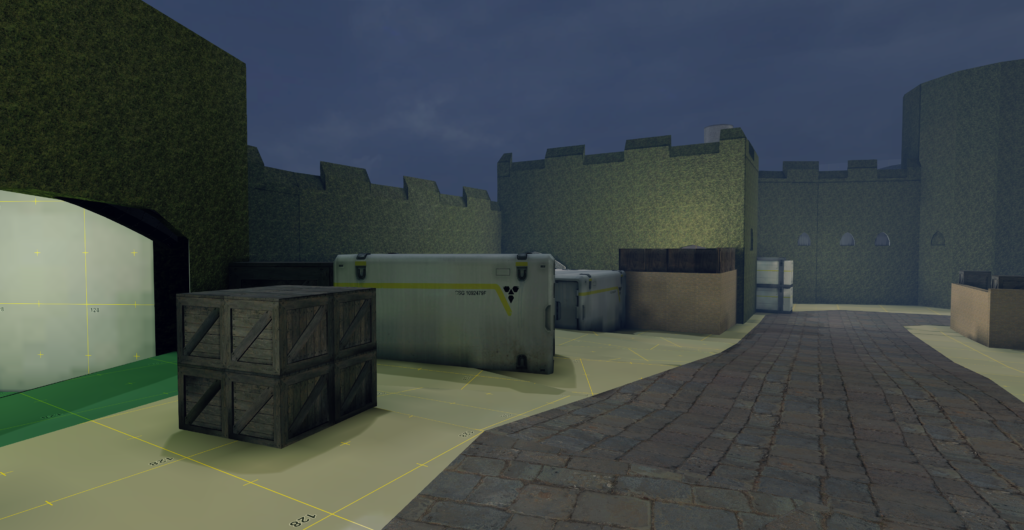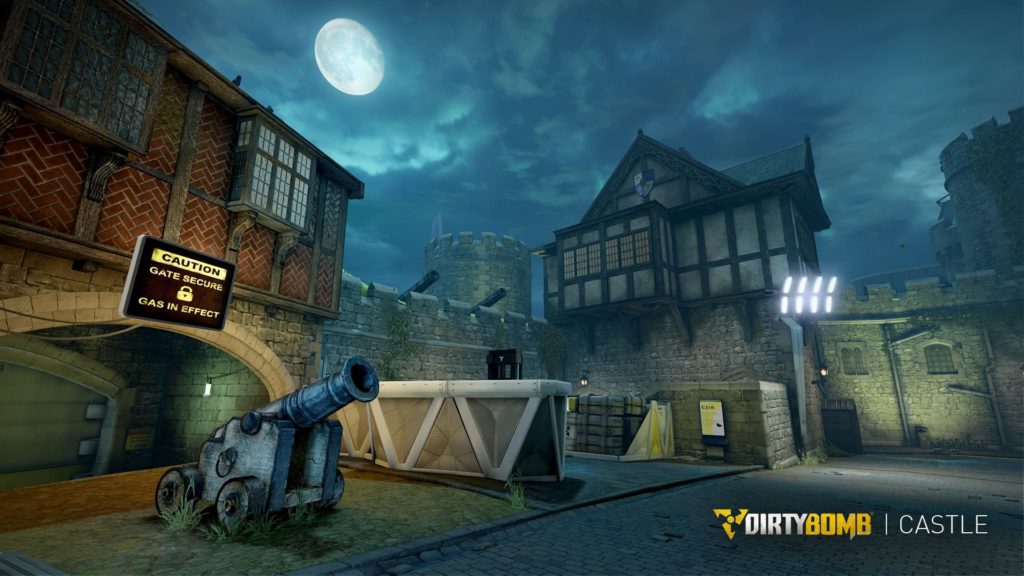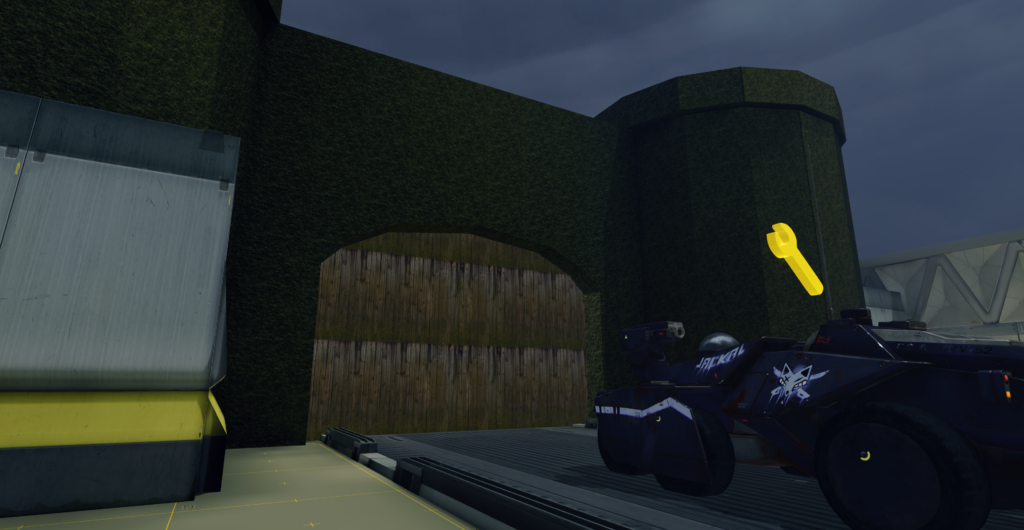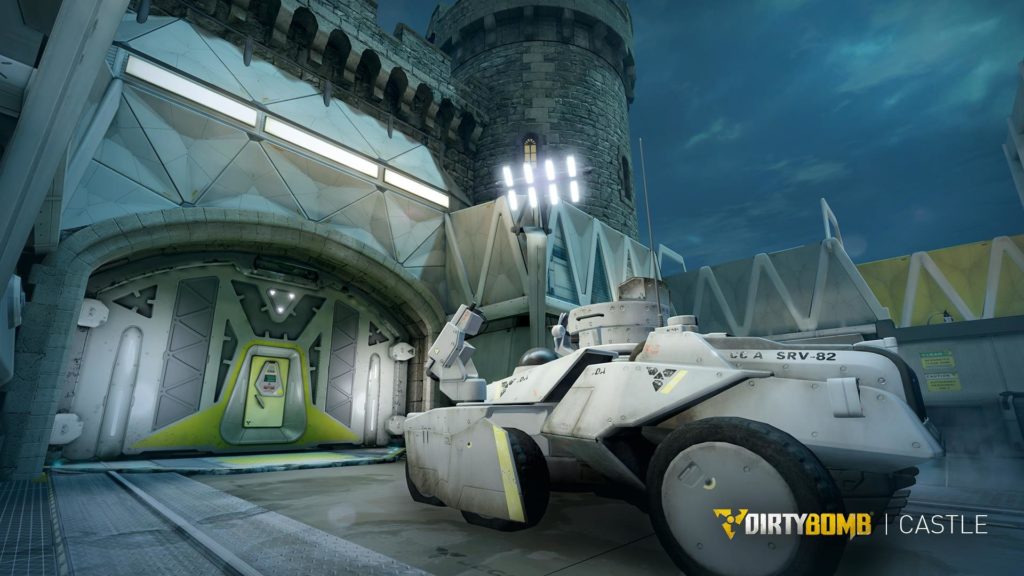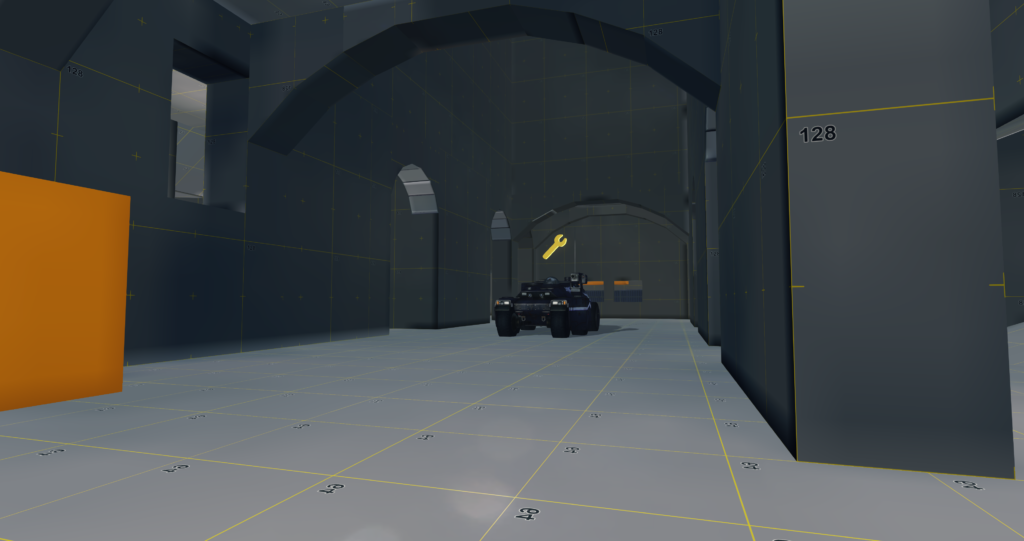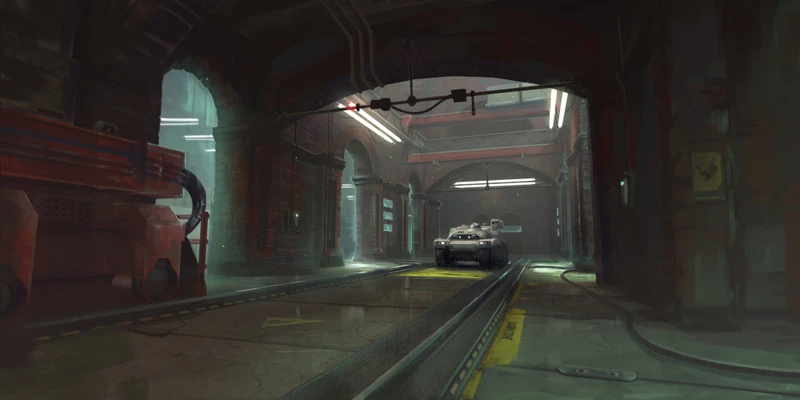Blocktober: Dirty Bomb
November 3, 2020
And here we are, the final part of our Blocktober series: Dirty Bomb.
We know, we know, it’s November, but it wouldn’t be Dirty Bomb related without a slight delay, right?
If you missed our Blocktober articles on Outcasters or Gears Tactics you can check them out as well.
We thought long and hard about this final article; would people even want to read about maps we never released? Would fans be disappointed about what might have been?
Ultimately, we decided that we wanted to share our learnings, share our lessons, and shed a bit of light on the process of making maps for Dirty Bomb.
So we’ll be starting with some broader discussions about level design in Dirty Bomb before moving into some specifics. Then we’ll go through Castle, the final Dirty Bomb map, and explore how it was made. Then we’ll be moving into two unreleased maps, Agency and Skyline, and talking about their design, what lessons we would have applied to them, and where they fit into the narrative.
So, without further ado, here’s two of our Level Designers, MassE and AK.
DESIGNING MAPS FOR DIRTY BOMB
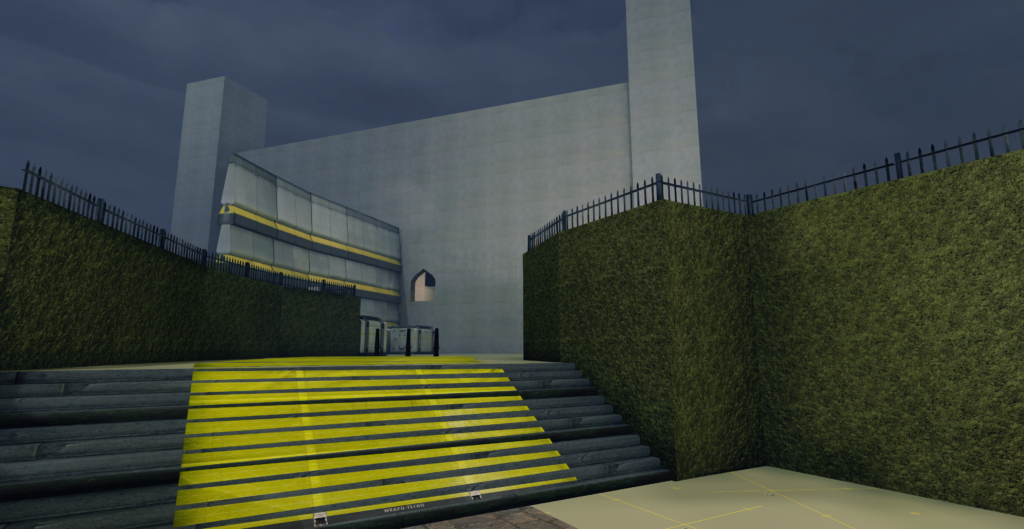
“Designing levels for Dirty Bomb is one of the most challenging and rewarding experiences I’ve had as a Level Designer,” said AK. “It’s first-person, it’s PvP, it has awesome movement mechanics, and an emphasis on team play; it’s a Level Designer’s dream!”
It’d be obvious to say you need to have an understanding of your game to build levels for it (and our Level Designers certainly did, with AK and MassE easily accruing the most hours on the team), but that rings even more true for Dirty Bomb.
“You obviously need to understand basic level design principles,” said MassE, “but you need a deeper, holistic understanding of the game to create maps that are well-balanced, fun, intuitive to navigate and that give opportunities for players to make meaningful tactical decisions.”
We talked a lot about it over the years, but Dirty Bomb’s core gameplay is what we’re most proud of. It has fast movement, wall hopping, varied abilities across an awesome cast of characters, and a tonne of weapons that all contribute to a high skill ceiling FPS. “Maps have to be designed to reflect all of that,” said AK, “but they also need to cater to the playstyles of our players, and our Mercs.”
THE OBJECTIVES
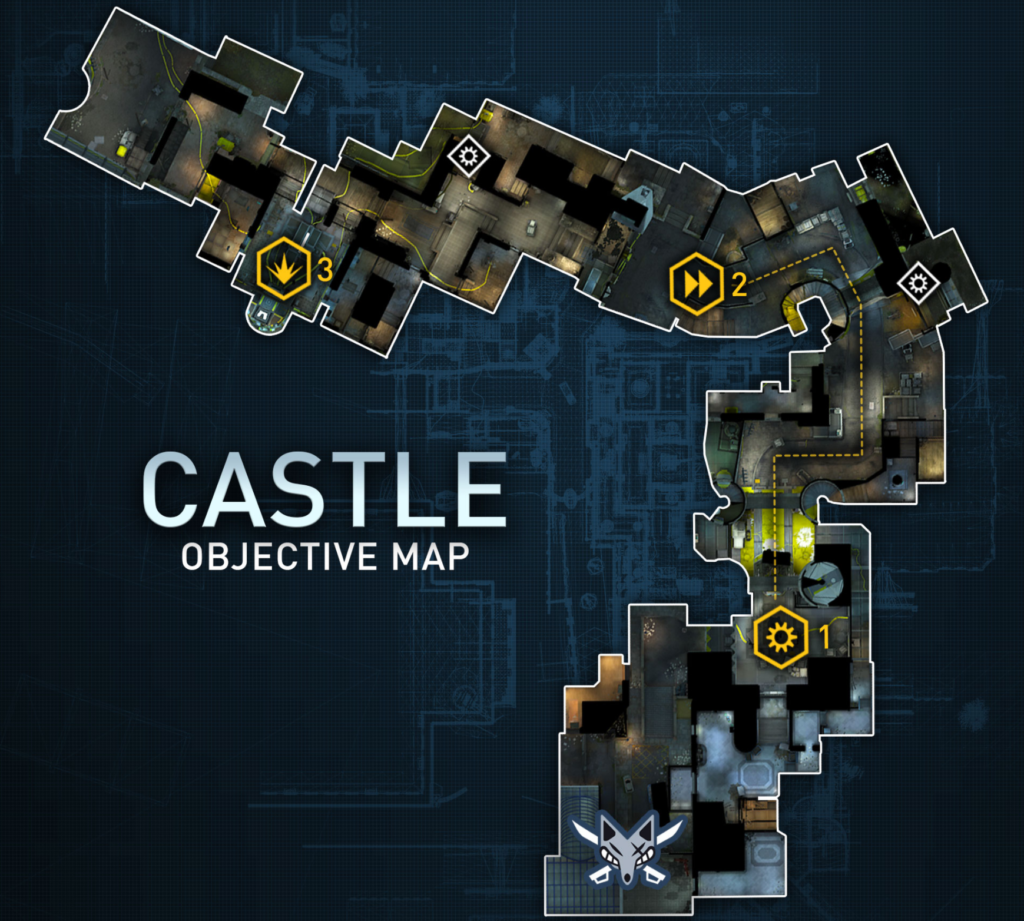
Dirty Bomb is built around objectives and they form the basis of our two main game modes: Stopwatch and Objective. In both, the attacking team fight against defenders to complete three objectives, one after another (in Stopwatch teams compete to see who can complete the objectives quicker).
The objectives are:
- Plant
- Deliver
- Escort
- Repair
“We could use the objectives in any order, really,” said AK, “but we always wanted to ensure blockbuster moments and a grand finale, so there were lots of discussions about how best to use them.”
That collaborative approach extended beyond discussions about objectives, though. In fact, Dirty Bomb was built on collaboration.
WHERE DO YOU START?
MassE has a simple answer; “A roundtable.” We paused. “Oh, did you need more? Well, making maps in Dirty Bomb wasn’t just a job for level design, we would talk to all teams and departments to get input; Marketing, Narrative, QA, Art, Design etc all had a say. Everyone pitched in.”
The narrative was clearly important for Dirty Bomb, and our players really connected to our world and characters, so pushing that story forward was always done with the utmost care.
Where we set the next map, for instance, was always an intense discussion.
THE LOCATION
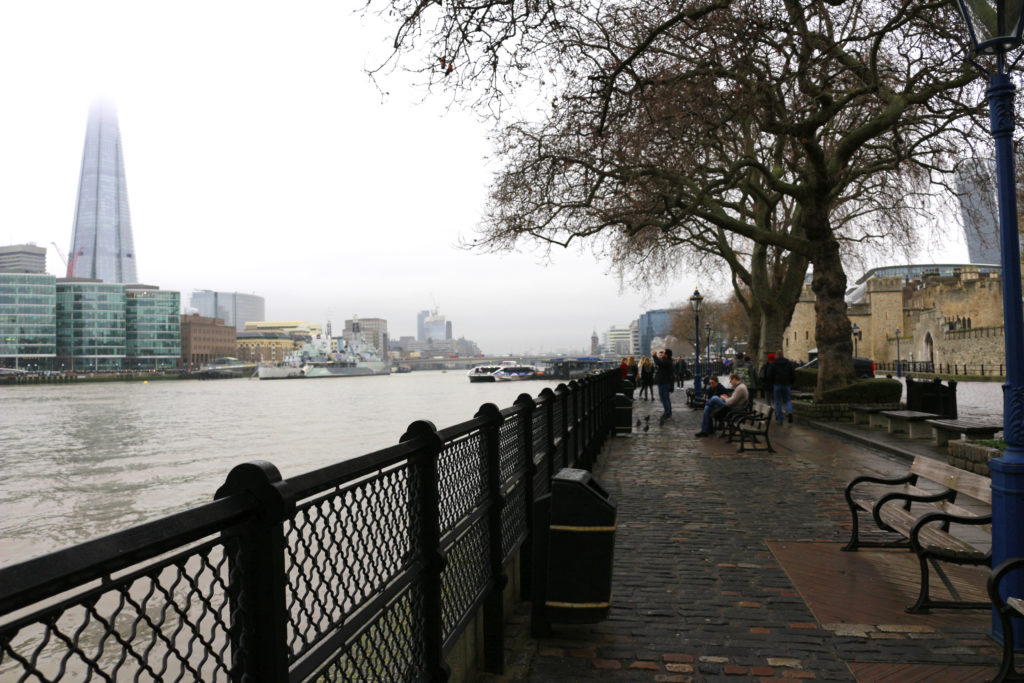
“Location has a massive impact on our level design,” said AK. “It sways the layout, the environment art, the narrative, how the map plays and flows etc, it’s such an important decision.”
MassE agrees; “We had to pick locations that gave us enough variety for the players to enjoy, and that allowed our roster of Mercs to shine. Not only that, but it had to be visually interesting throughout the level.”
We never wanted to use 1 to 1 replicas of real-life spaces (in part because we think it might be illegal…) but it was always restrictive to design, forcing our developers to be less creative. “We always try and capture the essence of a location instead,” said AK, “with familiar geometric shapes, spaces or landmarks.”
CASTLE AND MASSE’S FIRST MAP
The last level we published for Dirty Bomb fits this ethos perfectly. Castle, based loosely on The Tower of London, was also the first map MassE was responsible for.
“I’d been part of the Dirty Bomb team for around a year and a half, and most of my work was maintaining and updating existing maps, as well as supporting other features (like the reworked Tutorial and Assault Course).”
This approach allowed him to spend a significant amount of time deconstructing and analysing the game’s existing maps. “That time really allowed me to understand the level design in the game. I was learning how to manipulate gameplay in our existing maps, before carrying forward a very theory-driven, analytical design approach to my own work. This approach made Castle the map it is.”
But how was it decided that he was ready? After all, maps in Dirty Bomb were a huge time investment for a number of departments and couldn’t just be handed out.
AK, MassE’s senior on the project, had an answer: “We would always want to ensure that any Level Designer responsible for original map content would have a deep enough understanding of the game’s intricacies, and a solid understanding of the motivations of our players.”
But ‘leading’ on a level’s design isn’t as simple that, as MassE explained: “It was my responsibility to ensure that gameplay integrity and player experience was upheld while other disciplines added their expertise and craft into the mix.”
“One of the most vital parts of being a good Level Designer is something that isn’t often spoken about; that once art, audio, VFX etc are added to a map, you can lose some of the clarity and design intent from your original plans or blockouts.”
“You may have made your simple, blocky prototype play exactly as planned, but what if, for example, through the art phase, walls that were previously blank and grey are now very detailed and decorated with large red elements, making it more difficult to distinguish moving enemies from the environment?”
“Leading map development from a Level Designer’s point of view is largely about recognising and finding solutions to ensure that player experience and the gameplay is upheld through the many iteration cycles of development, not just creating a fun and engaging level layout.”
Once we’d settled on a lead and a location the work could begin in earnest.
FIELD TRIPS AND EARLY DESIGNS
“The first part of the approach was a field trip to the location to gather references and a feel for the area,” said AK. This is standard practice across the industry, though our exploration of key London landmarks drew a few raised eyebrows from and awkward conversations with Scotland Yard.
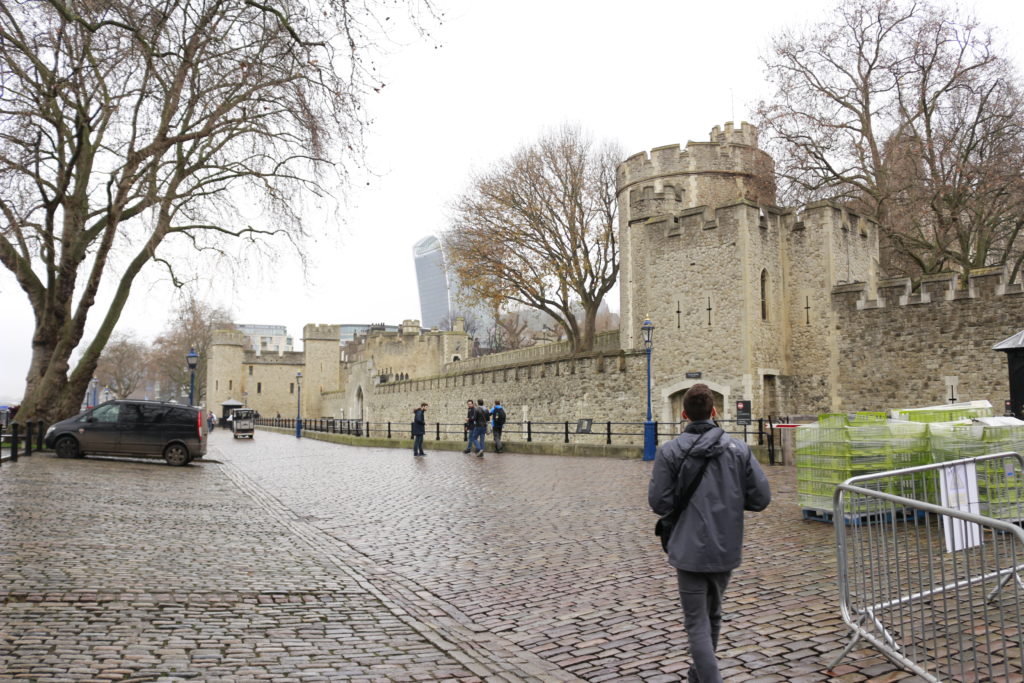
“We were looking at things like – how would that opening be transformed into a fun combat space, or how could we manipulate this stretch into interesting combat ranges.” Armed with these references, it was time to create high-level flow diagrams to help us link these spaces together.
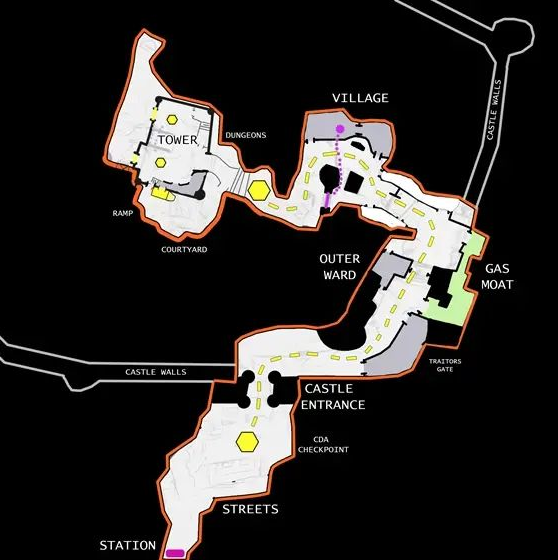
“These 2D top-downs are used to help us quickly build the level in the blockout stage,” said AK. “They also allow us to recognise potential problems or problem areas that might disrupt the flow from space to space.”
The final blockouts rarely look exactly like these top-downs (though the one below isn’t bad), but they play a crucial role in getting to an important milestone: the first playtest.
BLOCKING OUT
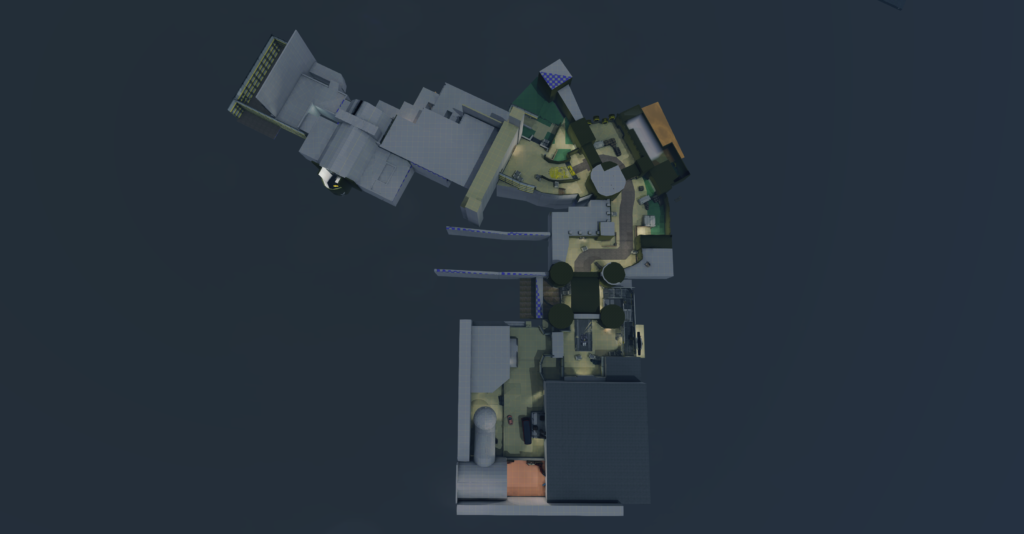
The next phase of development is something that’ll be familiar to you if you’ve been reading the rest of our Blocktober articles: blocking out the level.
Dirty Bomb’s maps were built using ‘BSP’ (Binary Space Partitioning). These are the grey surfaces you’ll see throughout Blocktober. We used them for all structures and cover but would drop in fully arted assets if they were appropriate for the area. For instance, if we were building a high street we would build the roads and buildings out of BSP and place arted props like cars and vans into that space.
“Blocking out a map is a huge task,” said AK, “so it’s important to keep the structures as simple as possible while you work before moving onto more detail-specific tasks.” Further complicating matters is the fact that each map in Dirty Bomb is essentially three maps that flow into one another.
“The scale of maps is always the hardest aspect to get right,” said MassE. “It’s important to plot your main paths and measure these distances; we’re looking for anything between 8 and 12 seconds from spawning to an objective.”
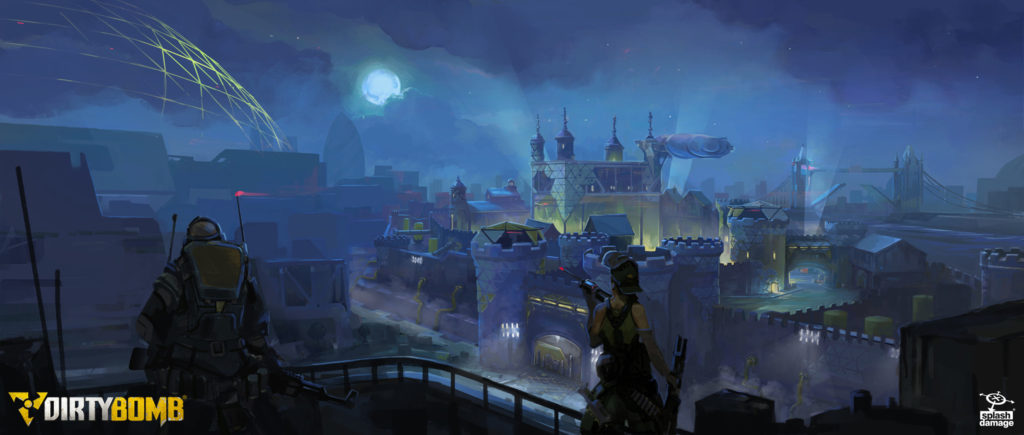
AK agrees; “Anything longer than that and players get frustrated when they respawn and have to run back. On the other hand, if the time is shorter it risks the map feeling too small for 8v8 matches, and can lead to chaotic gameplay.”
This stage is crucial to map development, but our team operated by a simple rule of thumb; if it feels long, it’s too long.
So we’ve started to account for player behaviour, what’s next? Well, Dirty Bomb has a whole host of characters, each with different weapons and abilities.
“Considering the Mercs is the next step. We had to look at combat ranges to allows our entire arsenal to function,” says MassE, “while also ensuring variety in combat spaces to allow our Merc’s abilities to be viable (like Skyhammer’s airstrike).” In real terms, this means considering the ratio between outdoor and indoor areas, ensuring characters like Kira or Skyhammer were viable.
PLAYTESTING AND ITERATING
Any fan of Dirty Bomb will be familiar with our approach to balance and design. You’ll have heard exedore talk about in videos, and MassE distils it simply:
“We combine our knowledge and experience of game design, some more analytical evidence, and then implement community feedback.”
Playtesting is, and was certainly for Dirty Bomb, a pivotal part in game design, and level design is no exception. “Collecting playtest data and feedback is essential for making improvements to a map,” said AK, “it’s at this crucial phase that we can make a good map become a great map.”
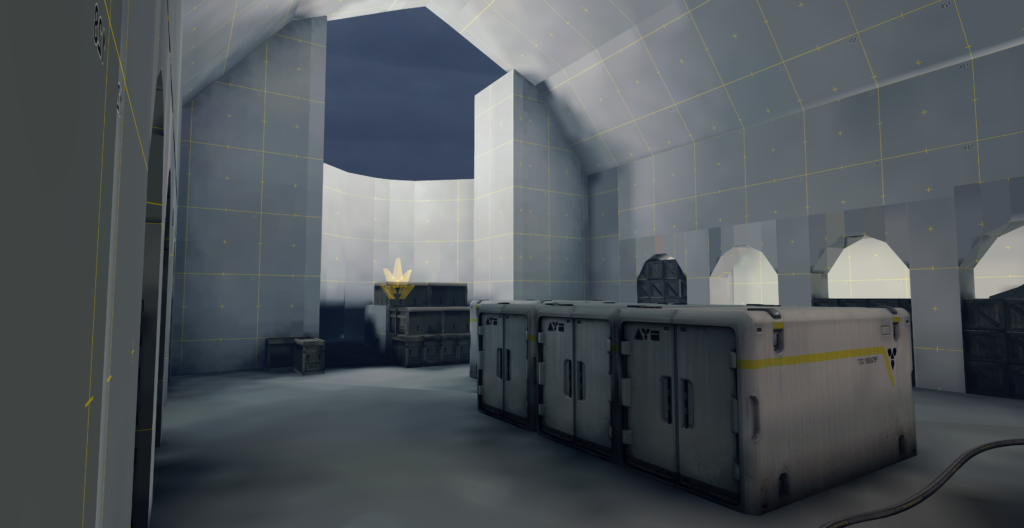
“We playtested every single day when developing maps,” said MassE, “the whole team would get involved! It was such a great time, and is probably why we had such a close-knit group and enjoyed working on the game so much.”
As you can imagine, we had players of all skill levels on the development team [they’ve insistent I say they were “mostly high skilled”], and who had a variety of play styles so the level design team were able to get a gauge on map balance.
“Getting to that first playtest was one of the most important stages of developing a map,” said AK. “Failing fast and being able to understand the issues is the quickest way to make improvements, so having a diverse team that can give good feedback is crucial. Then we as Level Designers can interpret that feedback and make meaningful iterations.”
UNRELEASED MAP: AGENCY
One map that had been through most of these phases was Agency. We’ve shown some of Agency once before, but we really wanted to go into more depth and show off some of the thinking behind the level.
To borrow from that original article, here’s Agency:
“Agency was to be a new Objective / Stopwatch map set in Central London. The vision for the map was to create a new space, with a new objective flow without adding new complex objective mechanics. It played off on the idea of a secret research lab under a spy agency, taking influence from the James Bond franchise, The Kingsmen and the Secret Intelligence Service building in London.
The SIS building was hastily abandoned by the British Government then locked up to keep out looters. The interior is somewhat messy because of the hasty evacuation and some bits of tech and equipment have been left behind.
The CDA decided to take over the building and make use of the facilities and take whatever they could find in the files, servers and research labs.”
DESIGNING AGENCY
Agency’s lead was Will Josephy, who has since moved on to another studio. You’ll have to make do with what the rest of us remember about the process!
Thankfully, AK remembers a fair amount: “Agency was another map that spawned during those roundtable discussions. We really wanted to make something Kingsman or James Bond-esque.”
Like Castle, the first port of call was a field trip to the MI6 building in Central London for inspiration and to gather reference images.
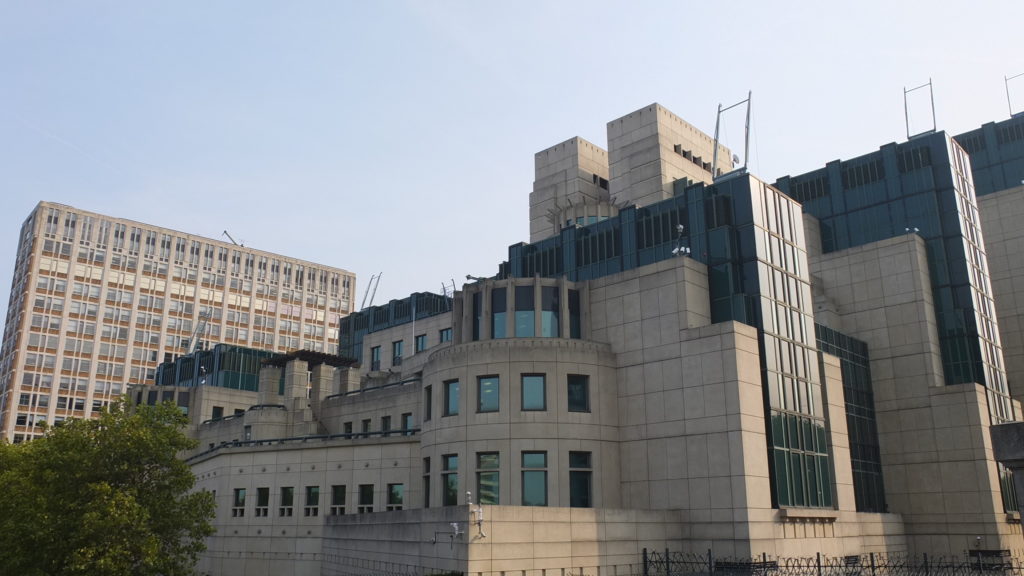
“We took a few photos while getting a couple of dodgy looks from security guards,” remembers MassE, “that was our cue to exit, but as we were crossing Vauxhall Bridge an armed police unit pulled us over and spoke to us. We explained as best we could, they ran a few checks (it turns out ‘Dirty Bomb’ isn’t a great name to explain while talking to the police), and they sent us on our way.”
Back safe in the confines of Splash Damage the team set to work on the flow diagrams and 2D top-down views.
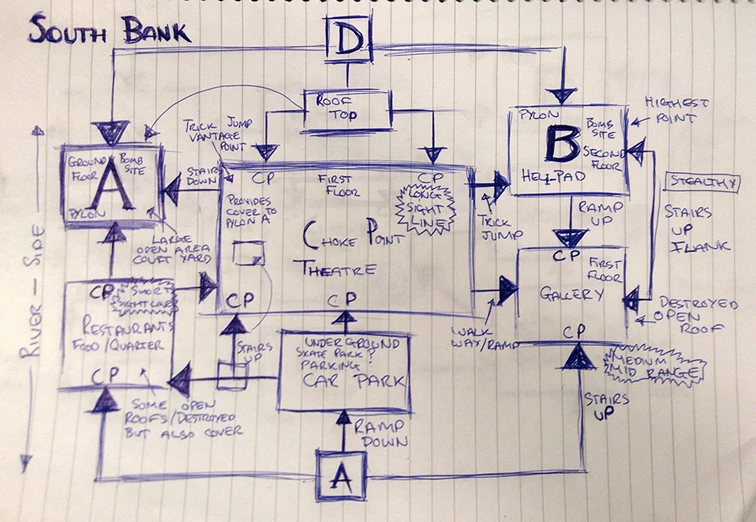
These rough layouts were then translated into something a little more akin to a Dirty Bomb map:
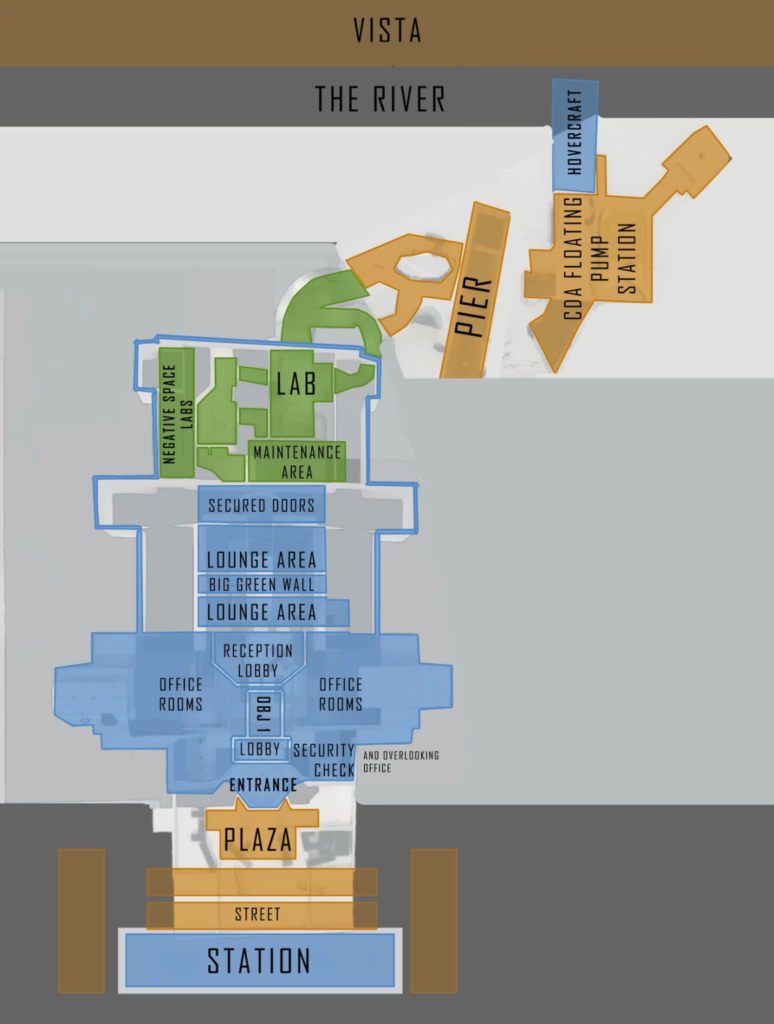
WHAT WAS INTERESTING ABOUT AGENCY?
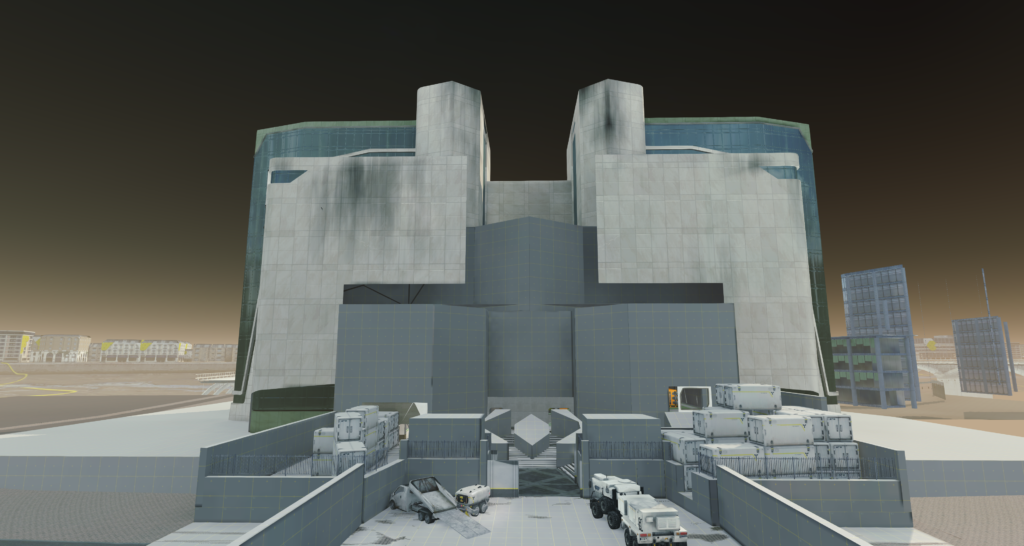
“In Agency we wanted to do something different with the objectives,” said MassE. “In previous Escort maps, Objective 1 was always repair the EV, Objective 2 was always escort the EV, while the third objective was always deliver or plant. Well, with Agency we started with a plant!”
“Planting the C4 disabled Agency’s security systems,” remembers AK, “giving players access to the secret underground labs where the prototype EV lay in wait. Then you’d repair it, escort it to the hovercraft and make a daring escape.”
Dirty Bomb had never had a map finish with the players escorting the EV. The team had tried it once before (in an alternate version of Bridge) but it felt a little anti-climactic, going against the design philosophy of ending on a big spectacle.
“We wouldn’t let the idea go,” said AK, “so we kept persevering, kept thinking of ways that it could work, and finally we got the chance to give it a go. We thought it was one of the most enjoyable escorts we’d ever done!”
UNRELEASED MAP: SKYLINE
So here we are. Many of you will have seen Agency before, but Skyline will be brand new to most of you. Skyline would see players fight across the rooftops of London to infiltrate the CDA Command Centre that controls the Containment Shield, with the aim of shutting it down.
HOW DID YOU START DESIGNING SKYLINE?
“Skyline also came from a roundtable,” remembers AK. “We thought it would be such a cool idea to be fighting over rooftops with London’s famous skyline as the backdrop.”
Not only was Skyline an ambitious map, but it also marked a finale for this arc of the story.
“Perhaps more so than any other map, the narrative fed directly into a lot of the design decisions of Skyline,” said MassE. “Skyline was to be the final chapter of this narrative arc. We knew that that had to take place in the CDA Headquarters, and we knew that one of the objectives would be delivering the two cores (stolen from Vault) to shut down the Containment Shield.”
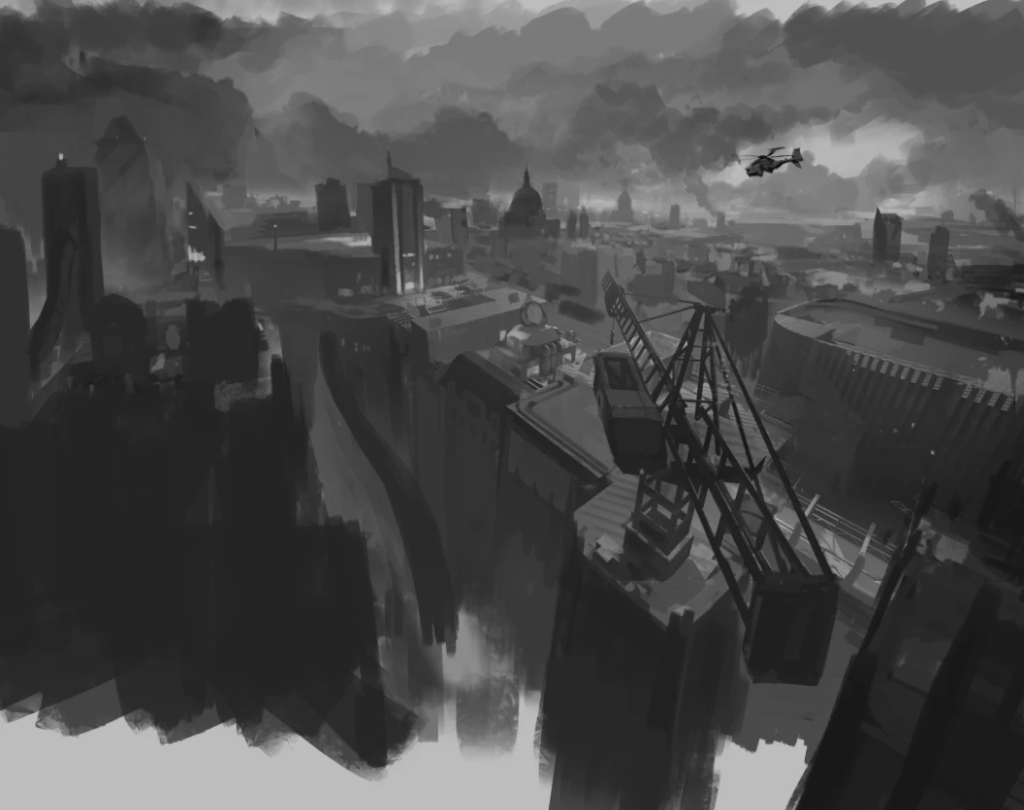
Far from being throwaway bits of story, we wanted all of our maps to connect. So in addition to stealing those two cores, we also had players finding the location of the CDA Headquarters by stealing data from the crashed airship in Dockyard etc.
“The initial design for Skyline would see the players escorting an EV across these rooftops, crashing through walls and snaking through the CDA corridors,” said AK. “However, given that both Castle and Agency featured escort objectives, we decided that players would be delivering objectives instead, ensuring variety in our maps.”
As with Castle and Agency, once the high-level structure and narrative had been decided it was time for top downs and flow diagrams, coupled with the start of our concept art which would help define key areas, tone, and the mood of the map:
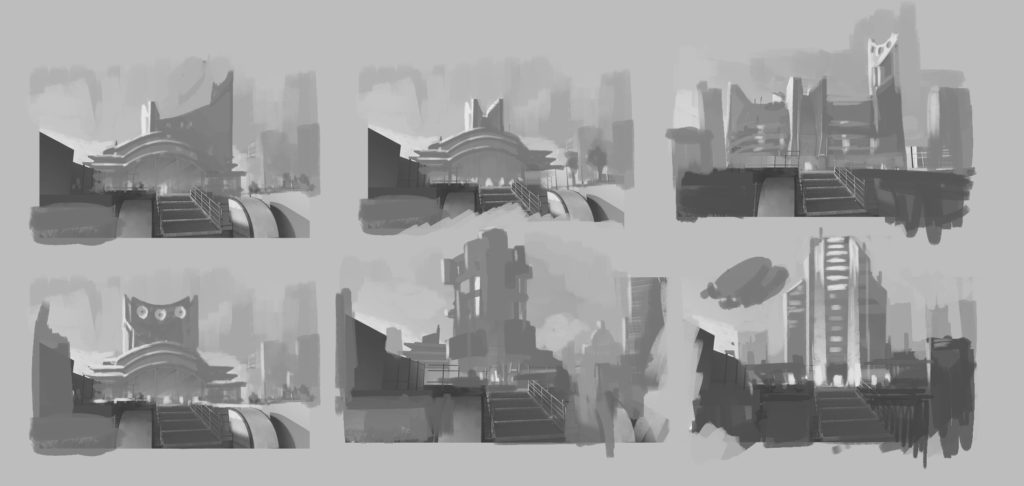
HOW IS SKYLINE DIFFERENT TO OTHER DB MAPS?
“Two things really stand out to me,” said MassE. “Firstly, being set on rooftops was completely new for Dirty Bomb and was the standout feature. Secondly, we were exploring the idea of a new objective type for Skyline; hacking. As with most things in Dirty Bomb our design was incredibly ambitious so it proved to be a little out of scope.”
“Instead,” said AK, “we decided to use the repair objective in a brand new way. Up until this point, repair had only ever been used in conjunction with the EV, now we would use it as it’s own standalone objective. It’s a fun objective to work with since, unlike planting the C4 and seeing it diffused, it doesn’t lose progress.
CAN YOU RUN US THROUGH THE OBJECTIVES?
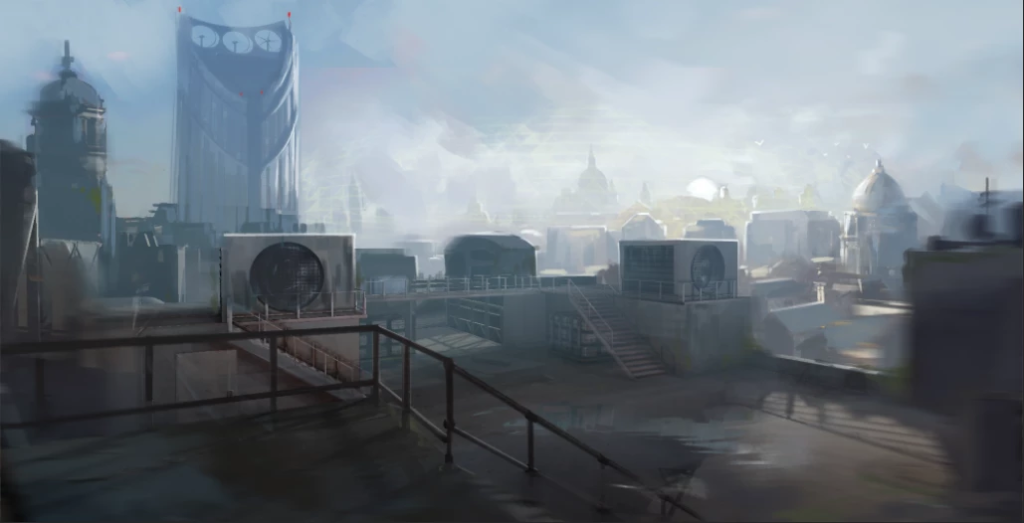
“I can, but this is going to look an awful lot like a bullet point list,” said AK, “Is that ok?”
It was ok since we’ve got a flythrough video (at the top of this section) to demonstrate some of these in a little more detail:
- Attackers being at the top of a high rise building, still under construction
- Attackers can repair a generator (a secondary objective) that closes a door and shuts down a route to the elevated vantage point.
- They must first repair a crane that creates a bridge to a neighbouring building that the CDA have conveniently positioned their anti-aircraft defences on.
- Next players must destroy the air defences (a laser-guided missile platform) before crossing over to infiltrate the CDA Command Centre. With the air defences down, a single Jackal helicopter drops off the override cores that had previously been stolen from Vault and Castle.
- Once again attackers are able to repair a generator that blocks off a route that gives defenders a shortcut to the objective.
- Now able to access the CDA Headquarters, the attackers must push up the stairs in the main area, making use of multiple flanking objectives.
- Finally, attackers must pick up the cores from the drop point and deliver them to the mainframe to push the energy levels of the shield to breaking point.
But what next? Well, Dirty Bomb’s Game Design Document teases the future of the narrative:
“Bringing down London’s CDA shield would have allowed Jackal to reveal the Sarcophagus. The one the CDA built around the original Dirty Bomb ground zero. Or rather, the site of the Event they staged the entire Dirty Bomb black op to cover up.
Why? They weren’t checking for radiological contamination around the Zone, they were re-contaminating it, every time. They staged Dirty Bomb attacks to force an evacuation away from the original Event. And inside the Sarcophagus, hidden from prying satellites and ground recon is – well, a secret we have yet to tell.”
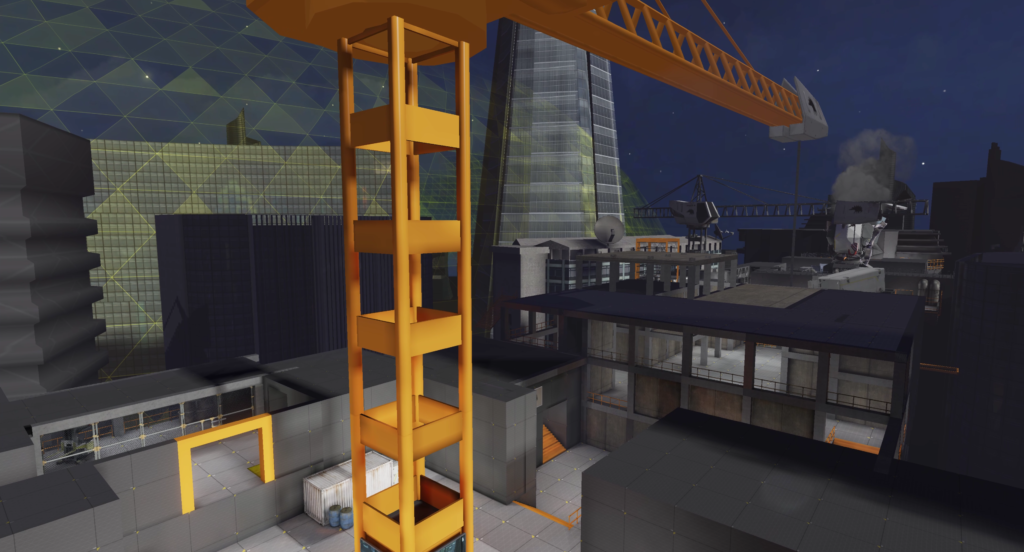
Phew. We did it! There’s always a tinge of regret when we talk about Dirty Bomb, and we know that many of you reading this will feel the same way. That said, we really wanted to talk in detail about this stuff to give DB fans an insight into what was coming, and how we were going about doing it.
Thank you so much for reading this deep dive into Dirty Bomb, and both our Outcasters and Gears Tactics blogs as well.
And, as ever, we’re hiring!
Until next year, happy Blocktober!

